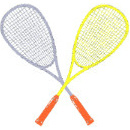

|
At Hanworth, we run school holiday and half-term sessions for kids from 5 years up to 12 years for squash and tennis, though we tend to stay indoors for the very young.
We go straight to extra bouncy junior squash balls with light kids' tennis rackets and aluminium framed 6 foot high indoor portable nets. If a child has grown up with rackets and balls, and has a reasonable ability to hit a ball to a height of 4ft and a distance of 8ft they can skip this period. It can take until ten years old for a child to develop a workable sense of coordination and timing.
My first question to parents of prospective players is, "Do they have a racket and ball at home ?." Why waste an hour a day through the holidays when quarter of an hour every day of the year at home would yield better results ?
Graduating from the nets to exercises and front court games, we will use blue 57 balls, but stay with the junior tennis rackets.
The next stage is to move on to the lightest racketball rackets we can find.
There is a gap in the availability of rackets and balls here. Young wrists find racketball rackets too heavy, and junior squash rackets find 57 balls too heavy. What is needed is a racketball racket designed along the lines of a junior squash racket, and a ball as bouncy as a beginner's blue racketball but halfway in size between that and a squash ball. I have not found a squash size ball with the right bounce for a junior.
As the player's wrist develops, they can move on to an adult racketball racket with a blue 57 ball, or an adult squash racket, with a warmed blue training ball, as they like.
At this stage, they are playing a front court game, and it is easy to spot the ones with good balance and ball judgement.
So far, players have been drilling individually or in groups under the coach.
Three quarter court can now be introduced, and the social aspects of learning and playing squash in group settings come as a revelation to some of these young developers. At this stage juniors can be encouraged to watch others for style and stroke, and it is important for the coach to encourage an atmosphere where criticism is take in a light hearted and everyday manner. A little warm banter about a player's shortcomings can produce often results with no resentment or embarassment.
It is important to explain to all budding improvers at this stage that to reach the highest levels the most relevant skill to practice is the ability to copy - to see a better player play with a certain style, or play a certain stroke, and be able to remember what is important about what you have seen, and to be able to practice doing it yourself.
Match play comes in here, and our junior ladder is always popular. We found that leagues don't do the trick with improving juniors - the ladder challenges a junior's sense of their own position in the skill spectrum, and the ladder challenge is the way to put that to the test. The competitive spirit is developing, and it is this that should drive the wish to work on drills.
Once serious, though short, matches are part of the equation, drills are needed to refine play.
Players should drill by themselves with a few rails and drops before they join in with others and warm up in pairs, or in a three quarter court session if facilities are limited.
If the group attending a session is so varied that there are too few players at each level for good match play, then use the regressive three quarter court variation, or set up a one session league table between two teams.
Give each game a handicap, and count points won. The main use of this kind of session is that non-players get a chance to watch better players for style as they walk around the court placing balls for less skilled opponents.
Copyright (C) Richard Hart 2015 - 2018